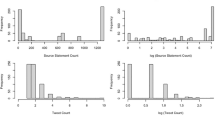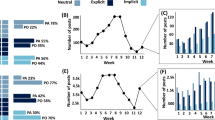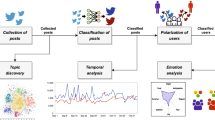Abstract
When an earthquake occurs, a huge amount of data is generated by social media users. Social networks play therefore a fundamental role in the development of decision support systems that could help both government and citizens. From user-generated contents, the information about an occurring emergency could be acquired and exploited to understand the critical event and its evolution over time. On the other side, the social interactions among users can be exploited as a dissemination gate to make people informed. In this paper, we present a decision support system for earthquake management based on machine learning and natural language processing to effectively extract and organize knowledge from online social media data. The proposed system, on a real Twitter dataset, has shown significant results for identifying messages related to (real) earthquakes and critical tremors, highlighting those posts provided by spontaneous users and containing any actionable knowledge about damages, magnitude, location and time references.





Similar content being viewed by others
Notes
Concerning the learning feature space, all the models enclosed in BMA are trained using a traditional vector space model representation (Salton et al. 1975) with a Boolean weighting schema.
T-Test rejects \(H_0: \mu _\text {BMA}-\mu _\text {other}=0\), where the critical region is \(T > 2.92\) and \(T=3.08\) with \(\alpha =0.05\). Then the test does not reject \(H_1: \mu _\text {BMA}-\mu _\text {other}>0\).
References
Aha DW, Kibler D, Albert MK (1991) Instance-based learning algorithms. Mach Learn 6(1):37–66
Avvenuti M, Cresci S, La Polla MN, Marchetti A, Tesconi M (2014a) Earthquake emergency management by social sensing. In: Proceedings of the international conference on pervasive computing and communications workshops, pp 587–592
Avvenuti M, Cresci S, Marchetti A, Meletti C, Tesconi M (2014b) EARS (earthquake alert and report system): a real time decision support system for earthquake crisis management. In: Proceedings of the international conference on knowledge discovery and data mining, pp 1749–1758
Cheng Z, Caverlee J, Lee K (2010) You are where you tweet: a content-based approach to geo-locating twitter users. In: Proceedings of the 19th ACM international conference on information and knowledge management, pp 759–768
Cortes C, Vapnik V (1995) Support-vector networks. Mach Learn 20(3):273–297
Crooks A, Croitoru A, Stefanidis A, Radzikowski J (2013) Earthquake: twitter as a distributed sensor system. Trans GIS 17(1):124–147
Fauffman M, Kugal K (2010) Syntactic normalization of twitter messages. In: Proceedings of the international conference on natural language processing
Fersini E, Messina E, Pozzi FA (2014) Sentiment analysis: Bayesian ensemble learning. Decis Support Syst 68:26–38
Fleiss JL (1971) Measuring nominal scale agreement among many raters. Psychol Bull 76(5):378
Jennex M (2012) Managing crises and disasters with emerging technologies: advancements. IGI Global, Hershey, PA
Lafferty JD, McCallum A, Pereira FCN (2001) Conditional random fields: probabilistic models for segmenting and labeling sequence data. In: Proceedings of the 18th international conference on machine learning, pp 282–289
Mahmud J, Nichols J, Drews C (2012) Where is this tweet from? inferring home locations of twitter users. In: Proceedings of the international conference on weblogs and social media, pp 511–514
McCallum A, Nigam K (1998) A comparison of event models for naive bayes text classification. In: Workshop on learning for text categorization-15th national conference on artificial intelligence, pp 41–48
Mikolov T, Sutskever I, Chen K, Corrado GS, Dean J (2013) Distributed representations of words and phrases and their compositionality. In: Advances in neural information processing systems, pp 3111–3119
Pan SJ, Yang Q (2010) A survey on transfer learning. IEEE Trans Knowl Data Eng 22(10):1345–1359
Pozzi FA, Fersini E, Messina E (2013) Bayesian model averaging and model selection for polarity classification. In: Natural language processing and information systems, pp 189–200. Springer, Berlin
Quinlan JR (2014) C4. 5: programs for machine learning. Elsevier, London
Sakaki T, Okazaki M, Matsuo Y (2010) Earthquake shakes twitter users: real-time event detection by social sensors. In: Proceedings of the 19th international conference on world wide web, pp 851–860
Salton G, Wong A, Yang C-S (1975) A vector space model for automatic indexing. Commun ACM 18(11):613–620
Yin J, Lampert A, Cameron M, Robinson B, Power R (2012) Using social media to enhance emergency situation awareness. IEEE Intel Syst 6:52–59
Author information
Authors and Affiliations
Corresponding author
Rights and permissions
About this article
Cite this article
Fersini, E., Messina, E. & Pozzi, F.A. Earthquake management: a decision support system based on natural language processing. J Ambient Intell Human Comput 8, 37–45 (2017). https://doi.org/10.1007/s12652-016-0373-4
Received:
Accepted:
Published:
Issue Date:
DOI: https://doi.org/10.1007/s12652-016-0373-4




